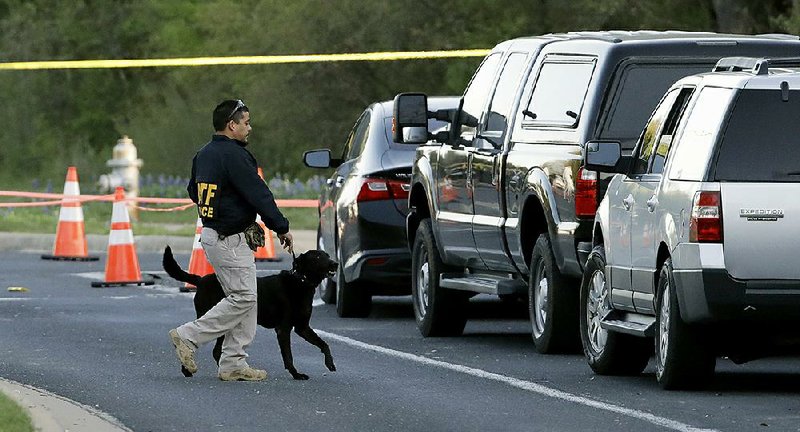AUSTIN, Texas -- The hunt for the bomber who has been leaving deadly explosives in packages on Austin doorsteps took a turn Monday when investigators said the fourth and latest blast was triggered along a street by a nearly invisible tripwire.
Police and federal agents said that suggests a "higher level of sophistication" than they have seen before, and means the carnage is now random, rather than directed at someone in particular. Underscoring that point, a relative said the most recent explosion left what appeared to be nails stuck in his grandson's knees.
"What we have seen now is a significant change from what appeared to be three very targeted attacks to what was, last night, an attack that would have hit a random victim that happened to walk by," Austin Police Chief Brian Manley said at a news briefing. "So we've definitely seen a change in the method."
"The game went up a little bit -- well, it went up a lot yesterday with the tripwire," Christopher Combs, FBI agent in charge of the bureau's San Antonio division, said in an interview.
Two people have now been killed and four wounded in bombings over a span of less than three weeks.
The latest blast happened Sunday night in southwest Austin's Travis Country neighborhood, injuring two men in their 20s who were walking in the dark. They suffered what police said were significant injuries and remained hospitalized in stable condition.
Police haven't identified the victims, but William Grote said his grandson was one of them, saying he is cognizant but still in a lot of pain. Grote said one of them was riding a bike in the street and the other was on a sidewalk when they crossed a tripwire that he said knocked "them both off their feet."
"It was so dark they couldn't tell and they tripped," Grote said. "They didn't see it. It was a wire. And it blew up."
That was a departure from the three earlier bombings, which involved parcels left on doorsteps that detonated when moved or opened.
Authorities repeated warnings about not touching unexpected packages and also issued new ones to be wary of any stray object left in public, especially one with wires protruding.
"We're very concerned that with tripwires, a child could be walking down a sidewalk and hit something," Combs said.
Authorities said they are looking at a range of possible motives, including domestic terrorism or that the bombings were hate crimes.
Local and state police and hundreds of federal agents are investigating, and the reward for information leading to an arrest has climbed to $115,000.
"We are clearly dealing with what we believe to be a serial bomber at this point," Manley said, citing similarities among the four bombs. He would not elaborate, though, saying he didn't want to undermine the investigation.
The first three explosives all hit east of Interstate 35, affecting areas where black and Hispanic residents live, prompting some to question whether the initial blast would have prompted more urgency had it gone off in a more affluent, predominantly white neighborhood. Sunday's blast was west of the highway.
"This is a public threat," Nelson Linder, president of NAACP's Austin chapter, said Monday. "Now that the geography has changed, it's going to widen people's perspectives. Nobody can take this lightly; we're all vulnerable."
Thad Holt, 76, said he is now watching his steps as he makes his way through a section of town near the latest attack. "I think everybody can now say, 'Oh, that's like my neighborhood,'" he said.
Many in the neighborhood where the fourth device detonated said they had felt removed from the terror that had shaken other parts of town.
"It appears that no one is safe, and I'm very fearful for our community," said Richard Herrington, 75, who was watching the NCAA men's basketball tournament when he heard the explosion Sunday night. "It's very concerning that this person is becoming more sophisticated."
Ellen Troxclair, a City Council member who represents the district where the Sunday explosion occurred, said she was shocked by seeing the blast there.
"The tripwire definitely instilled some fear into this neighborhood," she said. "They just want to know what's going on."
Fred Milanowski, agent in charge of the Houston division of the federal Bureau of Alcohol, Tobacco, Firearms and Explosives, said the latest bomb was anchored to a metal yard sign near the head of a hiking trail.
"It was a thin wire or filament, kind of like fishing line," he said. "It would have been very difficult for someone to see."
The explosions have occurred in a ring outside of Austin's core, which includes downtown, the Texas capitol and the university. The first two bombs were both deadly: Anthony Stephan House, a 39-year-old construction worker, was killed March 2. Then, 10 days later, Draylen Mason, a 17-year-old high school student, was killed in an explosion that injured his mother.
House and Mason were both related to prominent members of Austin's black community, and they had family members who are close, raising fears that their race or familial connections may have played a role.
Just hours after Mason was killed, a third bomb went off, seriously injuring Esperanza Herrera, a 75-year-old Hispanic woman who was visiting her mother.
Police had initially described the explosion that killed House as an isolated incident, though they reversed course 10 days later when the additional bombs detonated. Manley said Monday that police still do not have evidence leading them to a particular suspect, and he reiterated his plea to the public for tips and information.
Information for this article was contributed by Paul J. Weber, Will Weissert and Jim Vertuno of The Associated Press; and by Eva Ruth Moravec, Mark Berman and Meagan Flynn of The Washington Post.
A Section on 03/20/2018
